Daily News
by Gail Helmer
[ Send Us News | Archives ]
Codemasters is releasing Operation Flashpoint August 28. This is considered early, since it was announced last May that the game would reach U.S. stores in September. The product will include updated game code, improved multiplayer functionality, and new features including a dedicated server. Click here for our previous coverage.
New Team Factor Screens
Czech game developer 7FX has released 10 new screenshots from its upcoming team-based shooter, Team Factor. The new screens show off some of the different environments that will appear in the game, including both interior and exterior areas. The game will feature three different teams: red, which represents the Russian Spetznaz; blue, a combination of US Army Rangers and German Fallschirmjaegers; and black, which represents the rest of the world. Each team has four basic character types with unique abilities. The game will include more than 40 types of realistic weapons, including pistols, rifles, shotguns, grenades, and machine guns.
Team Factor is currently in the pre-alpha stage of development at 7FX. 7FX is currently preparing a two level game demo to be released the beginning of September. London based company Singularity Software will be publishing Team Factor. Release Date: Not Available.
F4Patch Standard41 RP5 Update
The F4Patch_Standard41_RP5 that was posted Sunday contained a few 3d model problems that caused a CTD in i2. An updated version has now been uploaded. If you downloaded the file on Sunday or Monday you may want to redownload it. Click here
A U.S. Navy flight test crew, flying a Northrop Grumman Corporation-produced E-2C Hawkeye airborne early warning and control aircraft equipped with a new Surveillance Infrared Search and Track (SIRST) sensor, successfully detected and tracked a theater ballistic missile target launched from the White Sands Missile Range in New Mexico.
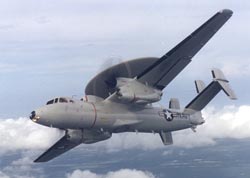
This was the first live-fire test of the SIRST sensor, under development for the Advanced Hawkeye by a team composed of the Navy, Northrop Grumman and the Raytheon Company. The successful July 9th test began a series of tests to demonstrate future naval technologies.
The goal of this program is to develop a fleet-wide missile detection and tracking capability for the Advanced Hawkeye, the next generation of the E-2C that is expected to follow after the current production Hawkeye 2000.
The heart of the SIRST system is a small infrared sensor located on the nose of the E-2C. Processors, controllers and displays inside the aircraft provide the detection and tracking information to the E-2C mission crew.
To support the SIRST Phase, Northrop Grumman developed the Universal Missile Simulator. It is a hardware-in-the-loop simulator that allows a variety of calibrated, simulated moving targets to be presented to an infrared search and track sensor for testing. The Universal Missile Simulator presents an image of a missile through a projection telescope so that it appears to be at a great distance. The missile launch scenario could be exactly repeated many times, and parameters varied, to generate confidence in a statistical probability of success of the SIRST, as shown by this first live-fire test.
"We went into this first test knowing it would perform well because of the successful number of simulated missile detections when evaluated against our Universal Missile Simulator," said Philip A. Teel, Northrop Grumman's Integrated Systems vice president for Airborne Early Warning and Electronic Systems (AEW&EW). SIRST performed even better than expected when confronted with an actual missile launch. This is a significant step in the development of the SIRST program, which will make the Hawkeye an even more important player in the overall fleet theater early warning and command and control concept of operations."
USAF Selects Sniper XR
The U.S. Air Force today announced Lockheed Martin's Sniper XR (eXtended Range) system as the winner of its Advanced Targeting Pod (ATP) competition. This 7-year contract with potential value in excess of $843 million marks the first deployment of 3rd generation targeting pods for the U.S. Air Force. The contract provides for up to 522 pods and associated equipment, spares, and support of the F-16 for both the Air Force and the Air National Guard.
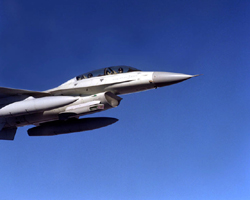
Sniper XR pods will initially equip the U.S. Air Force's F-16CJ Block 50 aircraft and the Air National Guard's F-16 Block 30 aircraft. Follow-on acquisitions are destined for the F-16 Block 40 and F-15E fleets, as well as many interested international customers, bringing product potential to several billion dollars. The scheduled contract delivery date is January 2003.
Sniper XR's outstanding performance is the result of a superior optical bed design combined with advanced image processing algorithms. Demonstrating exceptional stability and pointing accuracy in U.S. Air Force flight tests, Sniper performed very well throughout the entire F-16 flight envelope, including the supersonic region.
Dan Fischoff, Lockheed Martin program director, summarized Sniper's performance as "state-of-the-art." "Absolutely no other targeting system can match Sniper's performance, capabilities, and features. Everybody is a winner with this pod -- the warfighters, the crews, the maintainers and the taxpayers -- Sniper is the best value by any measure of merit."
A precision targeting system in a single, lightweight, affordable pod, Sniper XR is designed for current and future fighter aircraft. Incorporating a high-resolution, mid-wave 3rd generation FLIR, a dual-mode laser and a CCD-TV along with a laser spot tracker and a laser marker, Sniper vastly improves target detection/identification. The advanced image processing algorithms, combined with rock-steady stabilization techniques, deliver three times the performance of the best systems in service today. An additional feature of Sniper is its aircraft compatibility. Fully capable of being embedded or podded, Sniper technology is incorporated into Lockheed Martin's Joint Strike Fighter (JSF) design.
Fully compatible with the latest standoff weaponry, Sniper provides automatic tracking and laser designation of tactical size targets via real-time imagery presented on cockpit displays. Likewise, the supersonic, low-observable design results in a substantial reduction in drag and weight. Fischoff noted, "This pod is the result a concentrated effort by Lockheed Martin to field a truly advanced targeting system. Sniper and its leap-ahead technology represent the future for the precision strike mission. The system is simple to maintain, inexpensive, and tremendously capable. And it is ready now."
Army TACMS Block II LRIP Contract Awarded
Lockheed Martin Missiles and Fire Control has received a $165 million sole-source letter contract, with $82.4 million of the contract initially funded, for production of the Army TACMS Block II Missile from the U.S. Army Aviation & Missile Command, Redstone Arsenal, Ala.
The Low-Rate Initial Production (LRIP-IIIA) contract includes 19 Tactical Block II/BAT missile systems, three test missiles and logistics and test support requirements. The LRIP IIIA work will be performed at the company's Dallas and Horizon City, Texas, facilities and will be completed in December 2003.

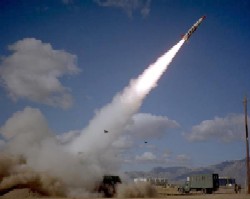
The Block II missile has a range of more than 80 miles (128 km). The Block II Continued Development contract was originally awarded to Lockheed Martin Missiles and Fire Control in July 1995. A Low-Rate Initial Production contract was awarded in June 1999.
The BAT submunition, produced by Northrop Grumman, has the lethality and intelligence to search out and destroy moving armor. The BAT submunitions are dispensed from Army TACMS by a gas bag management system. Once the Army TACMS warhead skin separates from the missile, the gas bags inflate, pushing the BATs out of the missile body. The BATs then activate and begin searching for targets.
Rise In Military Transport Aircraft Market
Military transport aircraft production will register steady gains through this decade, with the world's air forces expected to take delivery of nearly 870 new transports worth about $40 billion, according to a new market overview by Forecast International/DMS.
The composition of the Heavy Lift market during the 2001-2010 period will remain basically unchanged, with Boeing and Lockheed Martin continuing to dominate; the former on the strength of its C-17 strategic airlifter and the latter with its new C-130J. The seven-nation European consortium, meanwhile, remains committed to the planned A400M.
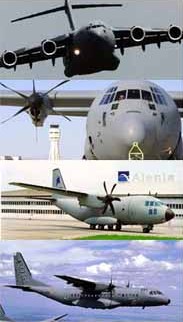
"This commitment is sounding more and more like an empty promise as none of the partners has yet anted up," said Senior Aircraft Analyst Bill Dane. Dane believes the jury is still out on this one and has not forecast a launch, instead anticipating selection of the C-130J for most of the planned A400M requirement. A modest C-17 purchase by the Europeans is also possible.
In the more competitive Medium Lift segment, the new Alenia C-27J and CASA C-295 types have logged their first orders and both are expected to be major players in the years ahead. According to Forecast International, both Australia and Poland have postponed planned medium transport buys but other sales prospects are drawing up their shopping lists and this segment will assume increasing significance in the coming years.
Russia and the Ukraine have each ordered five Antonov An-70 turboprops "but attempts to crack the international market with this very large design have thus far been unsuccessful," Dane said. Germany had been promoting the An-7X variant of the Antonov design as a lower-cost alternative to the A400M, but its partners rejected the Ukrainian design.
Dane believes that in terms of actual aircraft shipments, Lockheed Martin will increase its market lead during the next 10 years. "Orders for the new C-130J variant of the ubiquitous four-engined Hercules transport were initially slow off the mark but have been sufficient to sustain a steady if modest production rate," he said.
Boeing will lead the market throughout the next ten years in terms of sales revenues, boosted by projected follow-on C-17 orders from the US Air Force as that service's C-141 and C-5A models are retired. Boeing and the Air Force are trying to drum up interest in a BC-17X commercial cargo variant among the airlines in a plan which would involve subsidies to customers in exchange for USAF access to the aircraft in times of need.
Japanese Manufacturers Consider Joining Sonic Cruiser Project
Fuji Heavy Industries Ltd has revealed that it is considering joining forces on the US giant's 'Sonic Cruiser' programme along with Mitsubishi Heavy Industries Ltd and Kawasaki Heavy Industries Ltd. The three Japanese companies would supply technological input to the futuristic project, which aims to revolutionise commercial air travel.
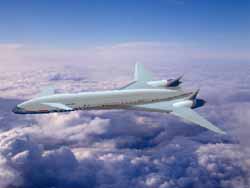
It has been reported by the Nihon Keizai Shimbun newspaper that the three will use sonic transport know-how, as developed under a Japanese government project, to assist Boeing, and that an agreement will be signed with a Japanese aerospace organisation this month.
''It's true that such a project is under consideration but nothing has been decided,'' said a spokesman for Fuji Heavy. The company is best known for producing Subaru cars but about eight percent of its revenue comes from aircraft parts.
Media speculation regarding possible collusion between Mitsubishi Heavy and Boeing on the project has been ongoing since April, because of previous project cooperation by the two companies. Furthermore, Mitsubishi was to build the main wing for Boeing's proposed superjumbo, the 747-X, before that programme was scrapped in March in favour of the sonic cruiser.
The proposed airliner, which will carry between 170 and 225 passengers, is designed to fly at 95 per cent of Mach 1. The jet is expected to ready for service between 2006 and 2008.
[ Send Us News | Archives ]
by Gail Helmer
Tuesday August 21, 2001
- Operation Flashpoint US Release Soon
- New Team Factor Screens
- F4Patch Standard41 RP5 Update
- Successful E-2C SIRST Testing
- USAF Selects Sniper XR
- Army TACMS Block II LRIP Contract Awarded
- Rise In Military Transport Aircraft Market
- Japanese Manufacturers Consider Joining Sonic Cruiser Project
PC News
Operation Flashpoint US Release SoonCodemasters is releasing Operation Flashpoint August 28. This is considered early, since it was announced last May that the game would reach U.S. stores in September. The product will include updated game code, improved multiplayer functionality, and new features including a dedicated server. Click here for our previous coverage.
New Team Factor Screens
Czech game developer 7FX has released 10 new screenshots from its upcoming team-based shooter, Team Factor. The new screens show off some of the different environments that will appear in the game, including both interior and exterior areas. The game will feature three different teams: red, which represents the Russian Spetznaz; blue, a combination of US Army Rangers and German Fallschirmjaegers; and black, which represents the rest of the world. Each team has four basic character types with unique abilities. The game will include more than 40 types of realistic weapons, including pistols, rifles, shotguns, grenades, and machine guns.
Team Factor is currently in the pre-alpha stage of development at 7FX. 7FX is currently preparing a two level game demo to be released the beginning of September. London based company Singularity Software will be publishing Team Factor. Release Date: Not Available.
F4Patch Standard41 RP5 Update
The F4Patch_Standard41_RP5 that was posted Sunday contained a few 3d model problems that caused a CTD in i2. An updated version has now been uploaded. If you downloaded the file on Sunday or Monday you may want to redownload it. Click here
Military News
Successful E-2C SIRST TestingA U.S. Navy flight test crew, flying a Northrop Grumman Corporation-produced E-2C Hawkeye airborne early warning and control aircraft equipped with a new Surveillance Infrared Search and Track (SIRST) sensor, successfully detected and tracked a theater ballistic missile target launched from the White Sands Missile Range in New Mexico.

This was the first live-fire test of the SIRST sensor, under development for the Advanced Hawkeye by a team composed of the Navy, Northrop Grumman and the Raytheon Company. The successful July 9th test began a series of tests to demonstrate future naval technologies.
The goal of this program is to develop a fleet-wide missile detection and tracking capability for the Advanced Hawkeye, the next generation of the E-2C that is expected to follow after the current production Hawkeye 2000.
The heart of the SIRST system is a small infrared sensor located on the nose of the E-2C. Processors, controllers and displays inside the aircraft provide the detection and tracking information to the E-2C mission crew.
To support the SIRST Phase, Northrop Grumman developed the Universal Missile Simulator. It is a hardware-in-the-loop simulator that allows a variety of calibrated, simulated moving targets to be presented to an infrared search and track sensor for testing. The Universal Missile Simulator presents an image of a missile through a projection telescope so that it appears to be at a great distance. The missile launch scenario could be exactly repeated many times, and parameters varied, to generate confidence in a statistical probability of success of the SIRST, as shown by this first live-fire test.
"We went into this first test knowing it would perform well because of the successful number of simulated missile detections when evaluated against our Universal Missile Simulator," said Philip A. Teel, Northrop Grumman's Integrated Systems vice president for Airborne Early Warning and Electronic Systems (AEW&EW). SIRST performed even better than expected when confronted with an actual missile launch. This is a significant step in the development of the SIRST program, which will make the Hawkeye an even more important player in the overall fleet theater early warning and command and control concept of operations."
USAF Selects Sniper XR
The U.S. Air Force today announced Lockheed Martin's Sniper XR (eXtended Range) system as the winner of its Advanced Targeting Pod (ATP) competition. This 7-year contract with potential value in excess of $843 million marks the first deployment of 3rd generation targeting pods for the U.S. Air Force. The contract provides for up to 522 pods and associated equipment, spares, and support of the F-16 for both the Air Force and the Air National Guard.

Sniper XR pods will initially equip the U.S. Air Force's F-16CJ Block 50 aircraft and the Air National Guard's F-16 Block 30 aircraft. Follow-on acquisitions are destined for the F-16 Block 40 and F-15E fleets, as well as many interested international customers, bringing product potential to several billion dollars. The scheduled contract delivery date is January 2003.
Sniper XR's outstanding performance is the result of a superior optical bed design combined with advanced image processing algorithms. Demonstrating exceptional stability and pointing accuracy in U.S. Air Force flight tests, Sniper performed very well throughout the entire F-16 flight envelope, including the supersonic region.
Dan Fischoff, Lockheed Martin program director, summarized Sniper's performance as "state-of-the-art." "Absolutely no other targeting system can match Sniper's performance, capabilities, and features. Everybody is a winner with this pod -- the warfighters, the crews, the maintainers and the taxpayers -- Sniper is the best value by any measure of merit."
A precision targeting system in a single, lightweight, affordable pod, Sniper XR is designed for current and future fighter aircraft. Incorporating a high-resolution, mid-wave 3rd generation FLIR, a dual-mode laser and a CCD-TV along with a laser spot tracker and a laser marker, Sniper vastly improves target detection/identification. The advanced image processing algorithms, combined with rock-steady stabilization techniques, deliver three times the performance of the best systems in service today. An additional feature of Sniper is its aircraft compatibility. Fully capable of being embedded or podded, Sniper technology is incorporated into Lockheed Martin's Joint Strike Fighter (JSF) design.
Fully compatible with the latest standoff weaponry, Sniper provides automatic tracking and laser designation of tactical size targets via real-time imagery presented on cockpit displays. Likewise, the supersonic, low-observable design results in a substantial reduction in drag and weight. Fischoff noted, "This pod is the result a concentrated effort by Lockheed Martin to field a truly advanced targeting system. Sniper and its leap-ahead technology represent the future for the precision strike mission. The system is simple to maintain, inexpensive, and tremendously capable. And it is ready now."
Army TACMS Block II LRIP Contract Awarded
Lockheed Martin Missiles and Fire Control has received a $165 million sole-source letter contract, with $82.4 million of the contract initially funded, for production of the Army TACMS Block II Missile from the U.S. Army Aviation & Missile Command, Redstone Arsenal, Ala.
The Low-Rate Initial Production (LRIP-IIIA) contract includes 19 Tactical Block II/BAT missile systems, three test missiles and logistics and test support requirements. The LRIP IIIA work will be performed at the company's Dallas and Horizon City, Texas, facilities and will be completed in December 2003.


The Block II missile has a range of more than 80 miles (128 km). The Block II Continued Development contract was originally awarded to Lockheed Martin Missiles and Fire Control in July 1995. A Low-Rate Initial Production contract was awarded in June 1999.
The BAT submunition, produced by Northrop Grumman, has the lethality and intelligence to search out and destroy moving armor. The BAT submunitions are dispensed from Army TACMS by a gas bag management system. Once the Army TACMS warhead skin separates from the missile, the gas bags inflate, pushing the BATs out of the missile body. The BATs then activate and begin searching for targets.
Rise In Military Transport Aircraft Market
Military transport aircraft production will register steady gains through this decade, with the world's air forces expected to take delivery of nearly 870 new transports worth about $40 billion, according to a new market overview by Forecast International/DMS.
The composition of the Heavy Lift market during the 2001-2010 period will remain basically unchanged, with Boeing and Lockheed Martin continuing to dominate; the former on the strength of its C-17 strategic airlifter and the latter with its new C-130J. The seven-nation European consortium, meanwhile, remains committed to the planned A400M.

"This commitment is sounding more and more like an empty promise as none of the partners has yet anted up," said Senior Aircraft Analyst Bill Dane. Dane believes the jury is still out on this one and has not forecast a launch, instead anticipating selection of the C-130J for most of the planned A400M requirement. A modest C-17 purchase by the Europeans is also possible.
In the more competitive Medium Lift segment, the new Alenia C-27J and CASA C-295 types have logged their first orders and both are expected to be major players in the years ahead. According to Forecast International, both Australia and Poland have postponed planned medium transport buys but other sales prospects are drawing up their shopping lists and this segment will assume increasing significance in the coming years.
Russia and the Ukraine have each ordered five Antonov An-70 turboprops "but attempts to crack the international market with this very large design have thus far been unsuccessful," Dane said. Germany had been promoting the An-7X variant of the Antonov design as a lower-cost alternative to the A400M, but its partners rejected the Ukrainian design.
Dane believes that in terms of actual aircraft shipments, Lockheed Martin will increase its market lead during the next 10 years. "Orders for the new C-130J variant of the ubiquitous four-engined Hercules transport were initially slow off the mark but have been sufficient to sustain a steady if modest production rate," he said.
Boeing will lead the market throughout the next ten years in terms of sales revenues, boosted by projected follow-on C-17 orders from the US Air Force as that service's C-141 and C-5A models are retired. Boeing and the Air Force are trying to drum up interest in a BC-17X commercial cargo variant among the airlines in a plan which would involve subsidies to customers in exchange for USAF access to the aircraft in times of need.
Japanese Manufacturers Consider Joining Sonic Cruiser Project
Fuji Heavy Industries Ltd has revealed that it is considering joining forces on the US giant's 'Sonic Cruiser' programme along with Mitsubishi Heavy Industries Ltd and Kawasaki Heavy Industries Ltd. The three Japanese companies would supply technological input to the futuristic project, which aims to revolutionise commercial air travel.

It has been reported by the Nihon Keizai Shimbun newspaper that the three will use sonic transport know-how, as developed under a Japanese government project, to assist Boeing, and that an agreement will be signed with a Japanese aerospace organisation this month.
''It's true that such a project is under consideration but nothing has been decided,'' said a spokesman for Fuji Heavy. The company is best known for producing Subaru cars but about eight percent of its revenue comes from aircraft parts.
Media speculation regarding possible collusion between Mitsubishi Heavy and Boeing on the project has been ongoing since April, because of previous project cooperation by the two companies. Furthermore, Mitsubishi was to build the main wing for Boeing's proposed superjumbo, the 747-X, before that programme was scrapped in March in favour of the sonic cruiser.
The proposed airliner, which will carry between 170 and 225 passengers, is designed to fly at 95 per cent of Mach 1. The jet is expected to ready for service between 2006 and 2008.
